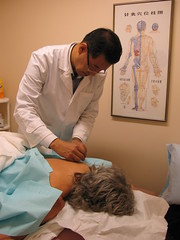Acupuncture for the treatment of cancer pain: a systematic review of randomised clinical trials
 |
| NYCTCM Acupuncture Clinic visit (Photo credit: NYCTCM) |
OncoPRN Commentary: Those working in any way in supportive oncology encounter a myriad of question with respect to complementary and alternative therapies (CAT). This article may better equip one to deal with the question of acupuncture and its use in cancer pain.
Excerpt:
Supportive Care in Cancer, 03/30/2012 Evidence Based Medicine
Choi TY et al. – The comparison between acupuncture plus drug therapy and drug therapy alone demonstrated a significant difference in favour of the combination therapy. The results of this systematic review provide no strong evidence for the effectiveness of acupuncture in the management of cancer pain. The total number of randomised clinical trials (RCTs) included in the analysis and their methodological quality were too low to draw firm conclusions.Methods:
"Fourteen databases were searched from their inception through April 2011.
Randomised clinical trials (RCTs) were included if acupuncture was used as the sole treatment or as a part of a combination therapy for cancer pain.
Studies were included if they were controlled with a placebo or controlled against a drug-therapy or no-treatment group.
The Cochrane criteria were used to assess the risk of bias.
Results:
- A total of 15 RCTs met the inclusion criteria.
- All of the included RCTs were associated with a high risk of bias.
- The majority of acupuncture treatments or combination therapies with analgesics exhibited favourable effects compared with conventional treatments in individual studies.
- However, a meta-analysis suggested that acupuncture did not generate a better effect than drug therapy (n=886; risk ratio (RR), 1.12; 95% CI 0.98 to 1.28; P=0.09).
- The comparison between acupuncture plus drug therapy and drug therapy alone demonstrated a significant difference in favour of the combination therapy (n=437; RR, 1.36; 95% CI 1.13 to 1.64; P=0.003).
- The results of this systematic review provide no strong evidence for the effectiveness of acupuncture in the management of cancer pain."
{Reference Link}
Read more...




















